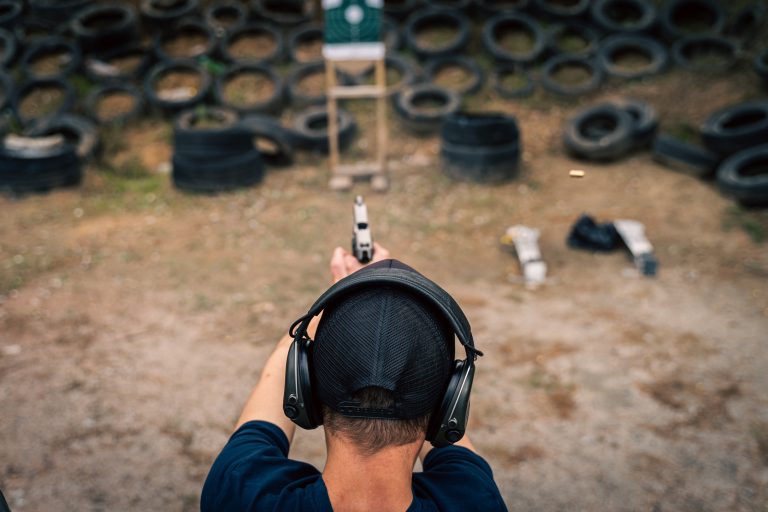Use of Force- Definition According to Indiana Statutes.
Disclaimer
The information contained is to be used only for information purposes only. It is not intended to be construed as legal advice and/or other advice. The information contained in this document is time sensitive and may become outdated, modified, and/or replace with more current information. We accept no liability for any injuries to person or property resulting from use of this information.

Use of Force- Definition
Indiana Code – Criminal Law and Procedure – Title 35, Section 35-41-1-25
“Serious bodily injury” defined
Sec. 25. “Serious bodily injury” means bodily injury that creates
a substantial risk of death or that causes:
(1) serious permanent disfigurement;
(2) unconsciousness;
(3) extreme pain; (temporary or permanent)
(4) permanent or protracted loss or impairment of the function
of a bodily member or organ; or
(5) loss of a fetus.
“Deadly Force” defined
Sec. 7 “Deady Force” Force that creates a substantial risk of serious bodily injury.
Indiana code IC 35-41-1-7, this code was repealed and is no longer in effect.
“Deadly weapon” defined
Sec. 8. “Deadly weapon” means the following:
(1) A loaded or unloaded firearm.
(2) A destructive device, weapon, device, taser (as defined in
IC 35-47-8-3) or electronic stun weapon (as defined in
IC 35-47-8-1), equipment, chemical substance, or other material
that in the manner it is used, or could ordinarily be used, or is
intended to be used, is readily capable of causing serious bodily
injury.
(3) An animal (as defined in IC 35-46-3-3) that is:
(A) readily capable of causing serious bodily injury; and
(B) used in the commission or attempted commission of a
crime.
(4) A biological disease, virus, or organism that is capable of
causing serious bodily injury.
Use of Force – The legal standard
The use of force shall be restricted to the following:
- The person reasonably believes that the force is necessary to prevent serious bodily injury or death to the person or a third-party person or to stop the commission of a forcible felony; not a misdemeanor.
- The person reasonably believes that the force is necessary to stop a forcible felony and the person believes that;
- The crime involved conduct including the use or threatened use of deadly force or serious bodily injury, or
- There is a substantial risk that the person to be stopped will cause death or serious bodily injury if the use of force is delayed.
- The person should give warning, if feasible, to the person against whom the deadly force is to be used.
Stand Your Ground Statutes
The legal notion of self-defense over the years has developed and/or expanded to include the application of Stand Your Ground Statutes/Castle Doctrine. In sum, Indiana Code 35-41-3-2 states that, “a person is justified in using reasonable force, including deadly force, against another person and does not have a duty to retreat…if the person reasonably believes that the force is necessary to prevent or terminate the other person’s unlawful entry of or attack on the person’s dwelling, curtilage, or occupied motor vehicle.” The key aspect of the above mention Indiana Code is that if an individual who is attacked in either their legally classified dwelling, curtilage, or occupied motor vehicle they are under no legal duty to retreat. Rather they can use any justifiable force, even deadly, to prevent or terminate the attacker’s unlawful entry or further aggressions.
It should be noted that the concept of self-defense extends even further than criminal liability/protections. There are also issues of civil liability attached to the application of self-defense. However, Indiana has recently passed the House Enrolled Act 1284. The main focus of the House Enrolled Act 1284 is to give more immunity to people who have used justifiable force in the manner of self-defense. Before the passing of the House Enrolled Act 1284 individuals could be justified under criminal statutory standards but maintain liability under civil statutory standards. Prior to Indiana passing the House Enrolled Act 1284 individuals could be free and clear of any jail time/criminal liability but could be liable for paying the family or the individual who was impacted the application of the victim’s self-defense actions. Thus, the passing of this act now allows for protection both criminal and civil liability when using justifiable force under the realm of self-defense.
Indiana does not have a brandishing law.
Indiana does have an intimidation with weapon law.
Full Legal Document
IC 35-41-3-2
Use of force to protect person or property
Sec. 2. (a) A person is justified in using reasonable force against another person to protect the person or a third person from what the person reasonably believes to be the imminent use of unlawful force. However, a person:(1) is justified in using deadly force; and
(2) does not have a duty to retreat;
if the person reasonably believes that that force is necessary to prevent serious bodily injury to the person or a third person or the commission of a forcible felony. No person in this state shall be placed in legal jeopardy of any kind whatsoever for protecting the person or a third person by reasonable means necessary.
(b) A person:
(1) is justified in using reasonable force, including deadly force, against another person; and
(2) does not have a duty to retreat;
if the person reasonably believes that the force is necessary to prevent or terminate the other person’s unlawful entry of or attack on the person’s dwelling, curtilage, or occupied motor vehicle.
(c) With respect to property other than a dwelling, curtilage, or an occupied motor vehicle, a person is justified in using reasonable force against another person if the person reasonably believes that the force is necessary to immediately prevent or terminate the other person’s trespass on or criminal interference with property lawfully in the person’s possession, lawfully in possession of a member of the person’s immediate family, or belonging to a person whose property the person has authority to protect. However, a person:
(1) is justified in using deadly force; and
(2) does not have a duty to retreat;
only if that force is justified under subsection (a).
(d) A person is justified in using reasonable force, including deadly force, against another person and does not have a duty to retreat if the person reasonably believes that the force is necessary to prevent or stop the other person from hijacking, attempting to hijack, or otherwise seizing or attempting to seize unlawful control of an aircraft in flight. For purposes of this subsection, an aircraft is considered to be in flight while the aircraft is:
(1) on the ground in Indiana:
(A) after the doors of the aircraft are closed for takeoff; and(B) until the aircraft takes off;
(2) in the airspace above Indiana; or(3) on the ground in Indiana:
(A) after the aircraft lands; and
(B) before the doors of the aircraft are opened after landing.
(e) Notwithstanding subsections (a), (b), and (c), a person is not justified in using force if:
(1) the person is committing or is escaping after the commission of a crime;
(2) the person provokes unlawful action by another person with intent to cause bodily injury to the other person; or
(3) the person has entered into combat with another person or is the initial aggressor unless the person withdraws from the encounter and communicates to the other person the intent to do so and the other person nevertheless continues or threatens to continue unlawful action.
(f) Notwithstanding subsection (d), a person is not justified in using force if the person:
(1) is committing, or is escaping after the commission of, a crime;
(2) provokes unlawful action by another person, with intent to cause bodily injury to the other person; or
(3) continues to combat another person after the other person withdraws from the encounter and communicates the other person’s intent to stop hijacking,
attempting to hijack, or otherwise seizing or attempting to seize unlawful control of an aircraft in flight.
IC 35-41-3-3
Use of force relating to arrest or escape
Sec 3
- A person other than a law enforcement officer is justified in using reasonable force against another person to effect an arrest or prevent the other person’s escape if:
(1) a felony has been committed; and
(2) there is probable cause to believe the other person committed that felony.
However, such a person is not justified in using deadly force unless that force is justified under section 2 of this chapter.
(b) A law enforcement officer is justified in using reasonable force if the officer reasonably believes that the force is necessary to effect a lawful arrest. However, an officer is justified in using deadly force only if the officer:
(1) has probable cause to believe that that deadly force is necessary:
(A) to prevent the commission of a forcible felony; or
(B) to effect an arrest of a person who the officer has probable cause to believe poses a threat of serious bodily injury to the officer or a third person; and
(2) has given a warning, if feasible, to the person against whom the deadly force is to be used.
(c) A law enforcement officer making an arrest under an invalid warrant is justified in using force as if the warrant was valid, unless the officer knows that the warrant is invalid.
(d) A law enforcement officer who has an arrested person in custody is justified in using the same force to prevent the escape of the arrested person from custody that the officer would be justified in using if the officer was arresting that person. However, an officer is justified in using deadly force only if the officer:
(1) has probable cause to believe that deadly force is necessary to prevent the escape from custody of a person who the officer has probable cause to believe poses a threat of serious bodily injury to the officer or a third person; and
(2) has given a warning, if feasible, to the person against whom the deadly force is to be used.
(e) A guard or other official in a penal facility or a law enforcement officer is justified in using reasonable force, including deadly force, if the officer has probable cause to believe that the force is necessary to prevent the escape of a person who is detained in the penal facility.
(f) Notwithstanding subsection (b), (d), or (e), a law enforcement officer who is a defendant in a criminal prosecution has the same right as a person who is not a law enforcement officer to assert self-defense under IC 35-41-3-2.
Four Pillars of Justifiable Force (Indiana does not differentiate between force and deadly force)
Ability: Weapon
This is the physical capability to kill or seriously injure. Sometimes this means a weapon such as a knife, club, or gun. It can also mean “Disparity of Force.” Disparity of Force in this context is when there is a large enough difference between the attacker and the attacked that raw physical capability alone is enough to be recognized as Deadly Force. The typical examples are a group attack, though unarmed, against a single individual, or the proverbial attack by a 300 pound enraged linebacker against a 90 year old fragile boned grandmother. Martial Artists, take note: there have been a few court cases which have ruled that martial arts training constitutes Deadly Force because of the, assumed, greater skill that the martial artist possesses. Same for Military and LEO training.
Opportunity: People could be harmed
Opportunity is similar to Ability, in that it reflects a raw ability to inflict grievous harm. However, Opportunity is more often linked to physical proximity. If the attacker is not within range to perform the attack then there is no threat. An attacker with a knife 30 feet away is no attacker at all. On the other hand, an attacker with a firearm 30 feet away is most certainly within range to inflict bodily harm. An attacker must have the “Opportunity” to use his “Ability” for the attack to be a credible threat of Serious Bodily Harm or Death.
Imminent Jeopardy (Intent): Threat & Behavior
This means that the threat is immediate and that a “Reasonable Man” would believe, based on what information is available at the time, that the aggressor’s intent is to cause severe physical harm or death. A “Reasonable Man” is a legal fiction, a pretend person, if you will, constructed to be an “everyman,” a non-crazy, average Joe, with average knowledge, skills, and understanding. If a “Reasonable Man” could be said to believe that a threat is immediate, then it is “reasonable” to assume that you would too. Threats by the aggressor of some future attack do not satisfy Imminent Jeopardy while threats or actions that indicate an immediate, “right now,” intention do.
Preclusion:
This means that all other options preceding Deadly Force were either exhausted or were not viable. Some places have a Duty to Retreat law or legal precedent. Essentially these address the same issue. Legally and morally the individual must reasonably eliminate all other methods to stop an attack before resorting to Deadly Force. It is particularly important to note that this does not mean that the individual must first “try, fail, discard, and then try another” to eliminate all other options. Many options are eliminated by immediacy of the threat. As an example, one simply does not have time to call the police and report a burglar when an aggressor is in the process of assaulting you. Similarly, being prevented by the aggressor from leaving the area, such as if you were trapped up against a wall or had children with you, may preclude the Duty to Retreat.
Force Options
- Presence
- Verbal Commands
- Soft Empty hands
- Hard Empty Hands
- Intermediate Weapons
- Deadly Force
Variables Affecting the Use of Force
- Type of crime committed or attempted
- Relative size/stature/strength of the combatant
- Exigent circumstances/conditions
- Number of combatants
- Availability of backup
- Reaction time (opportunity = time + distance)
- Subject(s) access to weapons
- Subject(s) under the influence of alcohol and/or drugs
- Exceptional abilities/skills ie; martial arts
- Injury to or exhaustion of the combatant or to you
- Weather or terrain conditions
- Immediacy of danger to others
- Distance from subject to you
- Special knowledge ie; subject’s prior history of violence
Verbal Conflict Management (Verbal De-escalation)
Five-Step Hard Style
- Ask for cooperation
- Explain why you’re asking
- Present options
- Confirmation. Ask if there is anything you can say that will make the person cooperate.
- Act. If it is clear there will be no compliance, act decisively.
“No weapon that is fashioned against you shall succeed, and you shall confute every tongue that rises against you in judgment.” Isaiah 54:17







